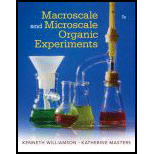
Macroscale and Microscale Organic Experiments
7th Edition
ISBN: 9781305577190
Author: Kenneth L. Williamson, Katherine M. Masters
Publisher: Brooks Cole
expand_more
expand_more
format_list_bulleted
Question
Chapter 9, Problem 6Q
Interpretation Introduction
Interpretation:
The detailed mechanism for the formation of fluorenone from fluorene should be written. Also, the purpose of the phase −transfer-catalyst should be explained.
Concept introduction:
The phase-transfer-catalyst is a catalyst that helps in the migration of the reactant molecules from one phase to another. It is a special kind of heterogeneous catalyst. Phase-transfer-catalyst is used in green chemistry, asymmetric alkylations, and in the preparation of polyester
Expert Solution & Answer
Want to see the full answer?
Check out a sample textbook solution
Students have asked these similar questions
Write the reaction mechanism between ethane and chlorine in the presence of light. Label each step and give a brief explanation.
write the free radical monosubtitution mechanism for the bromination of ethane to produce bromoethane
The aerobic oxidation of para-xylene to terephthalic acid is an important process in industrial chemistry. Discuss why the oxidation of the second methyl group requires harsher conditions than the oxidation of the first methyl group. You should accurately reference all your bibliographic material.
Chapter 9 Solutions
Macroscale and Microscale Organic Experiments
Knowledge Booster
Similar questions
- Interpret the acidity of alcohols on the basis of ground-state polarization and stability of the alcoholate anion(indicate and give symbols for bond polarization)! Compare the relative acidity of ethanol and 2-fluoroethanol!arrow_forwardWrite the complete mechanism (including intermediates) for the reaction of trans-stilbene with bromine in dichloromethane.arrow_forwardWrite the reaction mechanism for the bromination of ethene, ethane & ethynearrow_forward
- Explain the experimental procedure of the laboratory preparation of the synthesis of fluorobenzene from aniline (paragraph form) Explain the chemistry behind the synthesis of fluorobenzene from aniline (paragraph form)arrow_forwardExplain the general procedure for the laboratory preparation of the synthesis of fluorobenzene from aniline (paragraph form) Explain the chemistry behind the synthesis of fluorobenzene from aniline (paragraph form)arrow_forwardWith regards to this, I have been reading journals about activated carbon that is being modified. Now, the activated carbon is modified through acid treatment, and sulfuric acid is added to it. The result was, that there is a presence of SO3-, C=O=C, and C=O on the modified activated carbon. They concluded that the process of sulfonation on the activated carbon treated with sulfuric acid took place. Can you explain the chemistry/mechanism/reaction that happened? Explain in detail and clearly. Thank you so much!arrow_forward
- Write the mechanism for the bromination of ethane.arrow_forwardOutline the possible reaction pathways with proper mechanism for the formation ofNylon 6 from Benzene molecule.arrow_forwardwrite the complete reaction mechanism between ethylbromide (using steps and arrows ) and NaOH and determine the type of this reaction?arrow_forward
- Write the mechanism and predict the product for the reaction of cyclohexene with bromine. Make sure that you include the stereochemistry for the reaction in your mechanism. Then describe in detail the appearance of the reactants and products in this reaction. What would be the visible evidence that a reaction took place? Explain paragraph why no color change would occur upon mixing cyclohexanol with a solution of bromine.arrow_forwardChemistry what is the mechanism of the reaction between amine and dimethyl acetal (DMFDMA) in methanol? why does the reaction occur at high temperatures?arrow_forward(b) Explain the possible reagents for the following chemical reactions. I. 2. II. 1. `OH 2.arrow_forward
arrow_back_ios
SEE MORE QUESTIONS
arrow_forward_ios
Recommended textbooks for you
 Organic ChemistryChemistryISBN:9781305580350Author:William H. Brown, Brent L. Iverson, Eric Anslyn, Christopher S. FootePublisher:Cengage Learning
Organic ChemistryChemistryISBN:9781305580350Author:William H. Brown, Brent L. Iverson, Eric Anslyn, Christopher S. FootePublisher:Cengage Learning

Organic Chemistry
Chemistry
ISBN:9781305580350
Author:William H. Brown, Brent L. Iverson, Eric Anslyn, Christopher S. Foote
Publisher:Cengage Learning